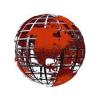

| Visitors Now: | |
| Total Visits: | |
| Total Stories: |

| Story Views | |
| Now: | |
| Last Hour: | |
| Last 24 Hours: | |
| Total: | |
Why Aren’t We Afraid Of A Tsunami Hitting San Francisco?
When a 7.3-magnitude earthquake struck off Japan’s eastern coast early Friday morning, we all feared a tsunami. But San Francisco gets earthquakes all the time, and we’re not scared of a tsunami there. Why?
When news broke of a 7.3-magnitude earthquake off the eastern coast of Japan early this morning, our first reaction was to fear a tsunami. The devastating earthquake that hit Japan last March and left 15,000 dead was in large part so damaging because of the ensuing tsunami, massive waves of ocean water which crashed up to six miles inland and over a hundred feet high. Luckily, today’s earthquake and its aftershocks seem to have had minimal adverse effect, and the waves are not high enough to be damaging.
But it got us wondering. The San Francisco Bay Area, perhaps the most famous earthquake zone in the continental United States, is hit by dozens of small earthquakes every year–and only a century ago, pretty much the entire city of San Francisco was flattened by an earthquake. Yet we never worry about a San Francisco tsunami. Is that lack of foresight, or is something else going on entirely?
Tsunamis–the word derives from the Japanese characters meaning “harbor” and “wave”–are not like regular waves. Though they can be triggered by underwater landslides or even meteorological conditions, typically they’re the result of immense energy being transfered by displaced ocean water. And what displaces ocean water? Earthquakes.
There are a few kinds of earthquakes, and the differences between the ones triggered by earthquakes is where we’ll find our answer to this question. Most earthquakes are caused by the movement of the plates of Earth’s crust moving against each other, which you all know, because you are all very bright. So there are a few kinds of “plate boundaries,” and there are a few different types of “faults.” The differences are confusing, because they’re very very similar, but you can think about them generally that a plate boundary describes in a large general sense the movement of plates, and faults describe how chunks of plates interact with each other. Since the question of San Francisco vs. Japan is a large-scale question, we’re going to talk with the large-scale language of plate boundaries.
So, plate boundaries! There are three main types: convergent, divergent, and transform. Convergent is when two plates smack into each other, divergent is when they move apart from each other, and transform is when they rub laterally against each other. We’re putting aside divergent for now, because neither San Francisco nor Japan have to worry about them.
The movement of plates isn’t smooth and it isn’t clean; the plates stick to each other, pop loose, bounce backward of forward like a rubber band. (Yep, when you’re talking about this much rock, it has a tendency to act elastic.) The most important term you need to know about convergent plates is subduction. Subduction is when an oceanic plate smashes into a land plate (or “continental” plate). Oceanic plates are made of heavier rock, so when the Pacific Plate smashed into Japan, it slipped under the Japanese land plate. That’s not how all convergent boundaries work; sometimes, two continental plates will smash into each other and built a mountain range at the smack-point, which is what’s happening between India and Asia right now. But subduction doesn’t give us the Himalayas–just a ton of trouble.
Subduction does crazy things to the seafloor. Remember that earthquakes aren’t smooth; these two plates have been smashing together for eons, sticking in places, being jammed down into the Earth’s mantle, and all of a sudden, POP! Parts of the seafloor behind the contact point are forced up, in weird, non-uniform spots. If you had a piece of cardboard hanging off the edge of a table, and folded the edge down, it’d force some of the cardboard still on the table upwards. That’s kind of what’s happening here; it’s not only where the two plates smash together that sees the impact. But a whole mess of the seafloor very suddenly pops up.
![[Image: tsunamialert.jpg]](http://www.popsci.com/files/imagecache/article_image_large/articles/tsunamialert.jpg)
![[Image: subductiongraph.jpg]](http://www.popsci.com/files/imagecache/article_image_large/articles/subductiongraph.jpg)
More: http://www.popsci.com/science/article/20…-francisco
2012-12-09 05:03:03
Source: http://yeoldefalseflag.com/thread-why-aren-t-we-afraid-of-a-tsunami-hitting-san-francisco
Source:


